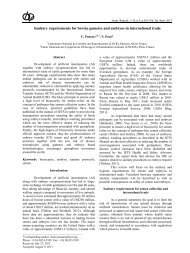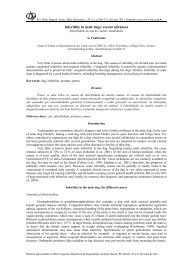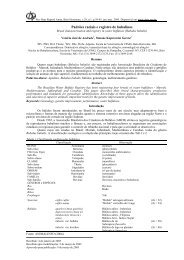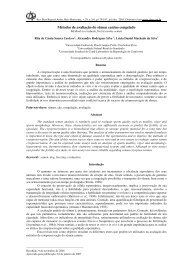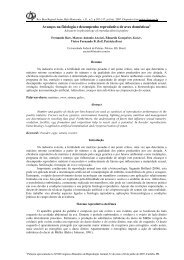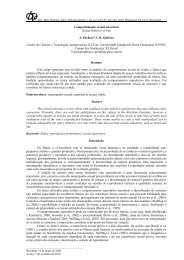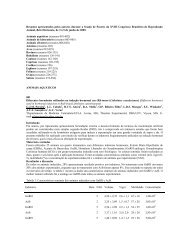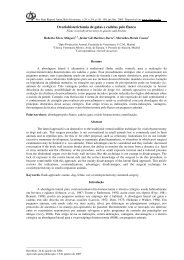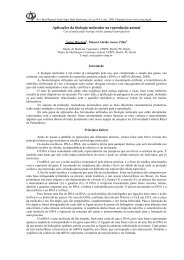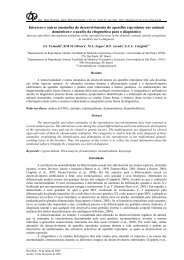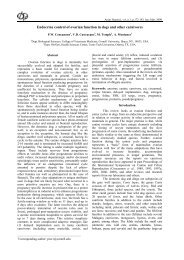Recent advances in ovulation synchronization and superovulation in ...
Recent advances in ovulation synchronization and superovulation in ...
Recent advances in ovulation synchronization and superovulation in ...
You also want an ePaper? Increase the reach of your titles
YUMPU automatically turns print PDFs into web optimized ePapers that Google loves.
Abstracts. II International Symposium on Animal Biology of Reproduction, Nov. 19-22, 2008, São Paulo, SP, Brazil.<br />
Ovarian crypts <strong>and</strong> germ<strong>in</strong>ative epithelium <strong>in</strong> P<strong>in</strong>nipeds<br />
A.S.D. Machado 1 , P.C. Papa 1<br />
1 Sector of Anatomy, Department of Surgery, Faculty of Veter<strong>in</strong>ary Medic<strong>in</strong>e <strong>and</strong> Animal Sciences, University of São Paulo,<br />
São Paulo, Brazil.<br />
Introduction<br />
Ovarian crypts were described for many p<strong>in</strong>nipeds species, besides the bitch others species such as, queen, cow <strong>and</strong><br />
woman. Their functions are not fully elucidated. Researches suggest that mesenchymal cells <strong>in</strong> the tunica albug<strong>in</strong>ea<br />
are bipotent progenitors for both primitive granulosa <strong>and</strong> germ cells (1). South–American-fur-seal (Arctocephalus<br />
australis) reproduction is largely <strong>in</strong>fluenced by environmental conditions. The species presents a s<strong>in</strong>gle annual<br />
estrus <strong>in</strong> early summer, generat<strong>in</strong>g only one offspr<strong>in</strong>g <strong>and</strong> shows a rapid corpus luteum <strong>in</strong>volution afterwards. This<br />
research <strong>in</strong>tends to elucidate the cellular composition of the ovarian crypts <strong>and</strong> to study its role <strong>in</strong> Arctocephalus<br />
australis ovarian physiology.<br />
Material <strong>and</strong> methods<br />
Ovaries of 13 Arctocephalus australis (5 adult <strong>and</strong> 8 young), with death by natural causes were collected <strong>in</strong> the<br />
reproductive colony of Cabo Polônio –Uruguay dur<strong>in</strong>g 2006 <strong>and</strong> 2007 (license CITES 000735). The samples were<br />
dissected <strong>and</strong> fixed by <strong>in</strong>fusion of 4% formal<strong>in</strong> <strong>and</strong> Karnovsky modified solution. Subsequently, 0.5 cm 3 fragments<br />
were obta<strong>in</strong>ed for optical <strong>and</strong> electronic microscopy analysis. Slides were submitted to hematoxyl<strong>in</strong>/eos<strong>in</strong>, Masson’s<br />
trichrome, aldehyde/fuchs<strong>in</strong> <strong>and</strong> picrosirius sta<strong>in</strong><strong>in</strong>g protocols for microscopical characterization.<br />
Immunohistochemistry for Ki-67 nuclear antigen was made <strong>in</strong> order to determ<strong>in</strong>e whether <strong>and</strong> which ovarian crypt<br />
cells are able to proliferate. Two superior can<strong>in</strong>e teeth of each animal were collected for age determ<strong>in</strong>ation.<br />
Results <strong>and</strong> discussion<br />
Morphologically ovarian crypts are tubular structure constituted by collagen (Fig.1–Bar 50μm) <strong>and</strong> elastic fibers<br />
(Fig.2–Bar 20μm) distributed <strong>in</strong> the ovarian parenchyma directed to the tunica albug<strong>in</strong>ea (Fig.3–Bar 50μm).<br />
Internally they are covered by germ<strong>in</strong>ative epithelium, which express great amount of Ki-67 antigen <strong>in</strong> epithelial<br />
cells (Fig.4–Bar 10μm). Scann<strong>in</strong>g Electronic Microscopic (SEM) showed different sizes of cells <strong>and</strong> presence of<br />
small <strong>in</strong>tra-crypt lumen (Fig.5–Bar 3μm). No important differences were found between the ages studied. Ki-67<br />
sta<strong>in</strong><strong>in</strong>g po<strong>in</strong>ts towards an <strong>in</strong>volvement of ovarian crypts <strong>in</strong> ovarian cell proliferation, probably contribut<strong>in</strong>g to neooogenesis<br />
(round shaped cells conta<strong>in</strong><strong>in</strong>g prom<strong>in</strong>ent nuclei).<br />
References<br />
(1) Bukovsky A, Caudle MR, Svetlikova M, Upadhyaya NB. 2004. Reprod Biol Endocr<strong>in</strong>ol, 2:20.<br />
Acknowlegments: CNPq, CAPES, PROFAUMA <strong>and</strong> DINARA/UY<br />
E-mail: mamiferomar<strong>in</strong>ho@gmail.com<br />
Fig.1 Fig.2 Fig.3<br />
Fig.4<br />
Fig.5<br />
Anim. Reprod., v.6, n.1, p.215, Jan./Mar. 2009 215



